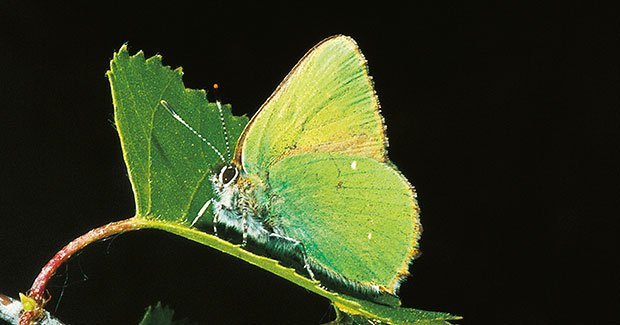Butterfly inspires nanodevice

THE STRUCTURES FOUND ON the wings of the green hairstreak butterfly (Callophrys rubi) have inspired the design of a tiny optical communication device.
The miniature device is called a ‘chiral beamsplitter’ and was the result of a joint project between Melbourne’s Swinburne University of Technology and the Friedrich-Alexander Universität Erlangen-Nürnberg in Germany.
The first of its kind, and even smaller than the width of a human hair, the device has potential application in high speed telecommunications. And it has the striking colour of a butterfly’s wings to thank for its existence.
“Our collaborator from Germany, and co-author on this paper, Dr Gerd Schröder-Turk is an expert in how complex structures such as the one found in the Callophrys rubi butterfly form and the geometrical properties they contain,” says Dr Mark Turner, a researcher in the project who is now working to develop new technologies in California’s Silicon Valley.
“The crystal structure we created is very similar to the nanostructured crystal structure within the wings of the butterfly.”
The secret behind butterfly’s intense wing colour
Butterflies are known to be master manipulators of light. Their colour typically arises from a combination of pigments and ‘structural’ colours – tiny physical structures which reflect light.
The colouration of the green hairstreak butterfly comes from extremely small, tightly packed springs, which reflect green light when light interferes with them.
When these particular structures were examined at 100,000 times magnification under an electron microscope, scientists discovered that they had a very unique geometry.
“It was a perfect blueprint for designing new polarisation sensitive materials,” says Mark. “We used the same mathematical network [in our crystal structure], just scaled up about four times larger.”
Technology inspired by nature
Studying the structure and function of biological systems for the purpose of engineering is a growing field known as biomimetics. Researchers are continually trying to learn more about elaborate structures found naturally and their potential application.
Thomas White, biologist at Macquarie University, is not surprised a butterfly wing has inspired this design.
“I think it’s fair to say that, as it stands, butterflies reveal the most diverse range of reflective structures of any animal group,” he says. “It is only in the last few decades, however, that we have been able to fully explore their complexity.”
Future breakthroughs in nanotechnology
Thomas notes that the green hairstreak butterfly is a particularly interesting species with complex three dimensional crystals embedded in their wings. The manipulation of light that these structures can achieve is an impressive optical feat relatively rare in nature.
“From a biological standpoint, it is still an open question as to why they need such elaborate architectures at all.”
Considering that a sizeable portion of the approximately 12000 butterfly species utilise structural colours, both Thomas and Mark agree that studying these structures will potentially unlock future technologies. Mark suggests that with the growth of nanotechnology in the past decade, we now have the tools to replicate and even improve on these biological designs.
RELATED STORIES
Climate change causing butterflies to emerge 10 days early
Cryptic creatures: the art of camouflage
Bubble findings aid cell research
Best science and nature photos awarded
AG reader photo: blue triangle butterfly
GALLERY: World’s tiniest flowers bloom in the lab
GALLERY: The incredible colours of birds
The microscopic world of pollen
Silkworms made to spin coloured silk
Scientists develop printable lasers

